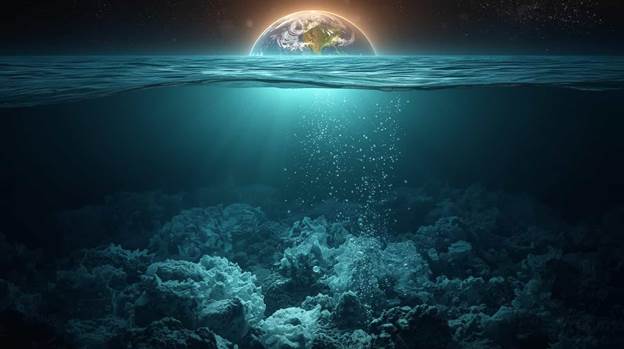The clathrate gun hypothesis suggests that rapid releases of methane from frozen hydrates beneath the seafloor could cause abrupt climate shifts. Methane, a potent greenhouse gas, is trapped within ice-like structures known as methane clathrates, found in ocean sediments and permafrost. When temperatures rise, these clathrates can destabilize, releasing vast amounts of methane into the atmosphere.
Table of Contents
This article explores the historical evidence of methane clathrate release events, their geological impacts, and what these past occurrences reveal about future climate risks.

Understanding the Clathrate Gun Hypothesis
The clathrate gun hypothesis proposes that when global temperatures rise, methane hydrates stored under the seabed melt rapidly, releasing methane gas into the atmosphere. This sudden release acts like “pulling the trigger” of a gun, amplifying warming and potentially driving major climate changes.
Methane’s greenhouse effect is 25 times stronger than carbon dioxide, making even small releases highly impactful. The term “gun” reflects how these events can accelerate warming uncontrollably once triggered.
Formation and Stability of Methane Clathrates
Methane clathrates form when methane gas becomes trapped inside crystalline water ice under high pressure and low temperature conditions typical of deep ocean sediments and Arctic permafrost. These frozen deposits remain stable only within specific pressure-temperature ranges.
When ocean temperatures rise or seafloor pressures change, these conditions shift, destabilizing the clathrates and releasing methane. Scientists have found that even slight warming can set off cascading effects, potentially accelerating global warming.
Historical Evidence of Methane Clathrate Release Events
1. The Paleocene–Eocene Thermal Maximum (PETM)
One of the strongest historical examples supporting the clathrate gun hypothesis occurred about 55 million years ago during the PETM. Global temperatures surged by 5–8°C over a short geological period, and massive amounts of carbon entered the atmosphere.
Researchers suggest this rapid warming was triggered by methane clathrate destabilization. Isotopic evidence from ocean sediments shows a significant drop in carbon-13 levels, consistent with methane release. This event led to ocean acidification, species migration, and mass extinction in marine ecosystems.
2. The End-Permian Extinction
Another potential example occurred 252 million years ago, during the Earth’s largest known extinction event. The end-Permian extinction, often called “The Great Dying,” wiped out over 90% of marine species.
Scientists believe that volcanic activity from the Siberian Traps released CO₂, warming oceans enough to destabilize deep methane hydrates. The subsequent methane release could have drastically amplified global temperatures, supporting the clathrate gun hypothesis as a key contributing factor.
3. Late Quaternary and Post-Glacial Periods
More recent evidence of smaller methane releases comes from the Late Quaternary period. As the last Ice Age ended about 12,000 years ago, rapid warming melted Arctic permafrost and destabilized methane hydrates.
Sediment cores from the Arctic Ocean reveal methane seepage zones that correspond with warming cycles. These findings suggest that clathrate release events have repeatedly influenced Earth’s climate transitions between glacial and interglacial periods.
Mechanisms Behind Methane Clathrate Destabilization
Thermal Warming
Rising ocean temperatures melt the upper layers of gas hydrates. Once the clathrate structure breaks down, methane bubbles rise through sediments and escape into seawater and eventually the atmosphere.
Pressure Reduction
When sea levels drop or ice sheets melt, the reduction in pressure can destabilize hydrate layers, releasing stored methane.
Submarine Landslides
Seafloor instability triggered by earthquakes or landslides can fracture hydrate-bearing sediments, allowing large methane releases in a short period.
Climate Impacts of Methane Release
1. Enhanced Greenhouse Effect
Methane traps heat effectively, intensifying the greenhouse effect. Once in the atmosphere, it accelerates warming, which can further destabilize other clathrate reservoirs—a dangerous feedback loop.
2. Ocean Acidification
When methane oxidizes in seawater, it produces carbon dioxide, lowering ocean pH. This process harms marine biodiversity, coral reefs, and shell-forming organisms.
3. Rapid Warming Cycles
Historical data show that large methane releases correlate with abrupt global temperature spikes. These rapid changes disrupt ecosystems and contribute to mass extinction events.

Modern Observations Supporting the Clathrate Gun Hypothesis
Today, scientists are witnessing early warning signs of potential clathrate destabilization in the Arctic Ocean and Siberian permafrost. Methane plumes have been detected rising from the East Siberian Arctic Shelf, where permafrost layers are thawing faster than expected.
While the scale of these emissions is still small, they highlight the real risk of future large-scale methane releases if warming continues unchecked.
Modern technology, including satellite monitoring and ocean floor sensors, allows researchers to track methane concentrations and temperature fluctuations in clathrate zones, strengthening our understanding of this complex feedback system.
Challenges and Uncertainties
Despite strong evidence, the clathrate gun hypothesis remains debated. Some scientists argue that methane hydrates release gas gradually rather than explosively.
Key uncertainties include:
- The rate at which hydrates respond to temperature increases
- How much methane reaches the atmosphere before dissolving in seawater
- Regional variations in clathrate distribution and stability
Nevertheless, historical records suggest that under certain extreme conditions, methane releases can indeed trigger rapid climate transitions.
Lessons from the Past and Future Implications
Studying historical methane clathrate release events provides insight into how Earth’s climate system responds to rapid greenhouse gas increases. The past shows that once triggered, these releases can create self-reinforcing warming cycles that are difficult to reverse.
Preventing such a scenario today means limiting further global temperature rise through sustainable energy transitions and careful Arctic monitoring.
Conclusion
The clathrate gun hypothesis reveals that Earth’s frozen methane reserves are not just passive elements of the climate system they are active players with the potential to accelerate warming dramatically. Historical evidence from events like the PETM and end-Permian extinction proves that methane clathrate releases can shape planetary climate trajectories.
Understanding these patterns is vital for predicting and preventing future climate shocks. As science advances, humanity must stay vigilant and act before this “climate gun” is triggered again.